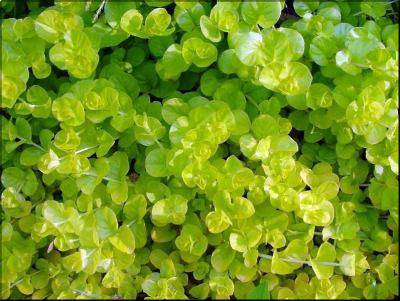Lysimachia nummularia “Aurea”
Scientific name: Lysimachia nummularia “Aurea”
Family: Myrsinaceae
Maximum size reached under cultivation: 15 - 25 cm (5.91 - 9.84 inch)
014
Recommended pH range: 6.1 - 7.8
Recommended water hardness: 4 - 18°dGH (71.43 - 321.43ppm)
0°C 32°F30°C 86°F
Recommended temperature range: 15 - 25 °C (59 - 77°F)
Preferred propagation method: Cuttings
Native to: Cultivated form / Hybrid
Growth rate: Normal
Recommended substrate: Fine gravel
Lighting requirements: Bright
Ideal placement in tank: Midground
Family
Myrsinaceae
Common Name
Golden Creeping Jenny
Propagation
Lysimachia nummularia “Aurea” propagates easily via stem cuttings. Simply trim a lateral shoot or healthy stem, remove the bottom leaf pairs, and gently insert the stem into fine gravel or moist substrate. Take care not to crush the stem during planting. While it rarely flowers underwater, it can flower when grown emersed. In paludariums and shallow setups, it may also spread naturally by creeping runners across moist surfaces.
Difficulty
Medium. Although the plant is hardy and tolerates a range of water parameters, it requires bright lighting and does best in emersed or semi-emersed conditions. Submerged growth is possible but may result in leaf loss or color fading. Best results are achieved in setups with high humidity and minimal water flow on the surface.
Short Description
Lysimachia nummularia “Aurea” is a golden-leafed cultivar of the European native creeping jenny. Known for its trailing habit and striking yellow-green leaves, it is a favorite for paludariums, ripariums, and the margins of garden ponds. While it can survive fully submerged for limited periods, it thrives when grown above the waterline with roots in moist substrate.
In aquarium use, it adds a splash of bright color and trailing form, especially in open-top or hybrid setups. Under ideal emersed conditions with high humidity and strong light, the leaves retain their signature golden hue. In submerged conditions, the plant tends to grow slowly and may lose its vivid coloration.
Maintenance and Care
This plant grows well in temperatures between 15–25°C (59–77°F), in soft to moderately hard water, and with a pH range of 6.1 to 7.8. Bright lighting is essential to preserve its coloration and compact growth. Regular trimming helps shape the plant and prevent overgrowth. While CO2 is not required, it can support healthier submerged growth. Avoid planting it in shaded areas, as the plant may become leggy or pale.
Compatibility
Lysimachia nummularia “Aurea” is compatible with most peaceful aquatic and semi-aquatic species. It works well in natural-themed layouts, especially in combination with mosses and carpeting plants. Because of its soft leaves, avoid housing it with large herbivorous or digging fish. In ponds and paludariums, it provides excellent color contrast and visual softness along the waterline.
Submersion and Aquascaping
This plant is best suited for semi-aquatic use, including paludariums and ripariums. While it may survive submerged for a time, it shows its best growth and color when allowed to grow emersed. It can be planted in shallow areas with only the roots submerged or allowed to trail from hardscape elements above water. In aquascaping, it adds a unique yellow tone and cascading structure to transition zones between water and land.
